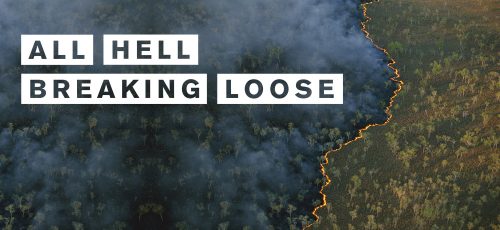
Or Going Off-Script in the Age of Trump
Andrew Bacevich
The impeachment of the president of the United States! Surely such a mega-historic event would reverberate for weeks or months, leaving in its wake no end of consequences, large and small. Wouldn’t it? Shouldn’t it?
Truth to tell, the word historic does get tossed around rather loosely these days. Just about anything that happens at the White House, for example, is deemed historic. Watch the cable news networks and you’ll hear the term employed regularly to describe everything from Oval Office addresses to Rose Garden pronouncements to press conferences in which foreign dignitaries listen passively while their presidential host pontificates about subjects that have nothing to do with them and everything to do with him.
Of course, almost all of these are carefully scripted performances that are devoid of authenticity. In short, they’re fraudulent. The politicians who participate in such performances know that it’s all a sham. So, too, do the reporters and commentators paid to “interpret” the news. So, too, does any semi-attentive, semi-informed citizen.
Yet on it goes, day in, day out, as politicians, journalists, and ordinary folk collaborate in manufacturing, propagating, and consuming a vast panoply of staged incidents, which together comprise what Americans choose to treat as the very stuff of contemporary history. “Pseudo-events” was the term that historian Daniel Boorstin coined to describe them in his classic 1961 book The Image: A Guide to Pseudo-Events in America. The accumulation of such incidents creates a make-believe world. As Boorstin put it, they give rise to a “thicket of unreality that stands between us and the facts of life.”

Making Sense of the Age of Carnage
Tom Engelhardt
My first question is simple enough: After 18-plus years of our forever wars, where are all the questions?
Almost two decades of failing American wars across a startlingly large part of the planet and I’d like to know, for instance, who’s been fired for them? Who’s been impeached? Who’s even paying attention?
I mean, if another great power had been so fruitlessly fighting a largely undeclared set of conflicts under the label of “the war on terror” for so long, if it had wasted trillions of taxpayer dollars with no end in sight and next to no one in that land was spending much time debating or discussing the matter, what would you think? If nothing else, you’d have a few questions about that, right?
Well, so many years later, I do have a few that continue to haunt me, even if I see them asked practically nowhere and, to my frustration, can’t really answer them myself, not to my satisfaction anyway. In fact, since 2001 — with the exception of the months leading up to the invasion of Iraq when America’s streets suddenly filled with hundreds of thousands of demonstrators asking a range of questions (“How did USA’s oil get under Iraq’s sand?” was a typical protest sign of that moment) — our never-ending wars have seldom been questioned in this country. So think of what follows not as my thoughts on the war in question but on the war in questions.

U.S. Troops Head for the Far North
Michael Klare
In early March, an estimated 7,500 American combat troops will travel to Norway to join thousands of soldiers from other NATO countries in a massive mock battle with imagined invading forces from Russia. In this futuristic simulated engagement — it goes by the name of Exercise Cold Response 2020 — allied forces will “conduct multinational joint exercises with a high-intensity combat scenario in demanding winter conditions,” or so claims the Norwegian military anyway. At first glance, this may look like any other NATO training exercise, but think again. There’s nothing ordinary about Cold Response 2020. As a start, it’s being staged above the Arctic Circle, far from any previous traditional NATO battlefield, and it raises to a new level the possibility of a great-power conflict that might end in a nuclear exchange and mutual annihilation. Welcome, in other words, to World War III’s newest battlefield.
For the soldiers participating in the exercise, the potentially thermonuclear dimensions of Cold Response 2020 may not be obvious. At its start, Marines from the United States and the United Kingdom will practice massive amphibious landings along Norway’s coastline, much as they do in similar exercises elsewhere in the world. Once ashore, however, the scenario becomes ever more distinctive. After collecting tanks and other heavy weaponry “prepositioned” in caves in Norway’s interior, the Marines will proceed toward the country’s far-northern Finnmark region to help Norwegian forces stave off Russian forces supposedly pouring across the border. From then on, the two sides will engage in — to use current Pentagon terminology — high-intensity combat operations under Arctic conditions (a type of warfare not seen on such a scale since World War II).
And that’s just the beginning. Unbeknownst to most Americans, the Finnmark region of Norway and adjacent Russian territory have become one of the most likely battlegrounds for the first use of nuclear weapons in any future NATO-Russian conflict. Because Moscow has concentrated a significant part of its nuclear retaliatory capability on the Kola Peninsula, a remote stretch of land abutting northern Norway — any U.S.-NATO success in actual combat with Russian forces near that territory would endanger a significant part of Russia’s nuclear arsenal and so might precipitate the early use of such munitions. Even a simulated victory — the predictable result of Cold Response 2020 — will undoubtedly set Russia’s nuclear controllers on edge.
